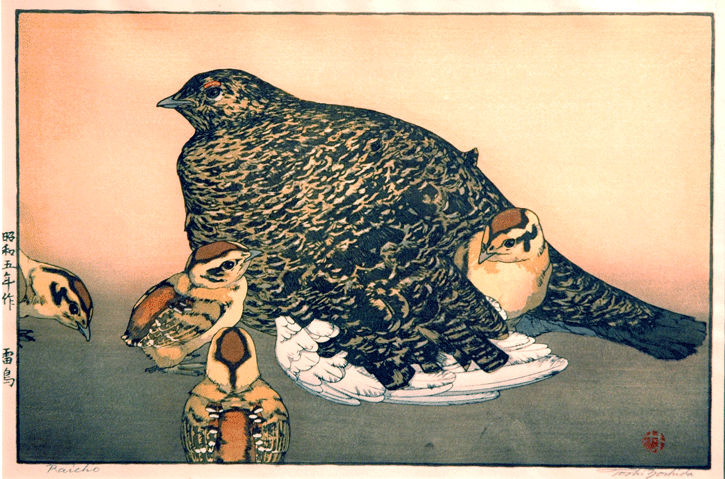Raicho, Toshi Yoshida, woodblock print, 1930
Raicho is the Japanese term for snow grouse. The idea for this work was inspired by a trip to Mt. Hakobayari, where Toshi and his father Hiroshi encountered a mother grouse and her chicks in their campsite. Hiroshi first created a work based on this motif, which focused on both the surrounding scenery and the chicks. He composed this work under the title of Raicho and Komagusa in 1926. A few years later, Toshi followed in his father’s footsteps by creating a similar motif. Toshi created one of his earliest woodblock prints capturing a mother grouse and her chicks in 1930, based on sketches he drew during the camping trip in 1926. Toshi chose to focus the work on the protective attitude of the mother bird toward her young. This was one of the first works in which he cut most of the woodblocks by himself, and he first displayed it under the title “Ptarmigan” in the Japan Society in 1953.
This work set him apart from this father, and established Toshi’s unique style. While Hiroshi’s work focused on landscapes, Toshi chose to depict wildlife. He was far more accomplished to this end than his father, for while Hiroshi’s depiction of the grouse and her young was competent, Toshi’s depiction captured the life and energy of the birds. As art historian Kendall H. Brown observed, the chicks “three dimensional volume and vitality stand in marked contrast to the rather flat and static rendering of the mother bird.” This early work helped Toshi Yoshida to establish a solid reputation as the most talented wildlife artist in the woodblock medium.
Lauren Dew and Rebecca Koch
